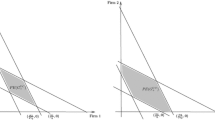Abstract
In this paper we investigate a model of duopolistic competition in an uncertain environment where the attitudes of the firms towards uncertainty are incorporated. In particular, we analyze an extension of a Cournot duopoly in which the firms face a different market demand in each of two scenarios, and make their output decisions before uncertainty is resolved. The way in which firms value the possible outcomes is critical when deciding their strategies. In real-life situations the attitudes that agents exhibit can vary from extreme pessimism to extreme optimism, and it is possible to characterize their behavior according to their degrees of optimism. In this context, we identify the sets of equilibria for the full range of degrees of optimism, and illustrate the results with the analysis of some cases in which the demand functions are linear.





Similar content being viewed by others
References
Aghassi M, Bertsimas D (2006) Robust game theory. Math Program 107:231–273
Bade S (2005) Nash equilibrium in games with incomplete preferences. Econ Theor 26:309–332
Caraballo MA, Mármol AM, Monroy L, Buitrago E (2015) Cournot competition under uncertainty. Conservative and optimistic equilibria. Rev Econ Design 19(2):145–165
Cournot AA (1838) Recherches sur les principes mathématiques de la théorie des richesses. Hachette, Paris
Crespi GP, Radi D, Rocca M (2017) Robust games: theory and application to a Cournot duopoly model. Decis Econ Finance 3:1–22
Fanti L, Gori L, Sodini M (2013) Nonlinear dynamics in a Cournot duopoly with different attitudes towards strategic uncertainty. In: Abstract and applied analysis, vol 2013, Article ID 323290. https://doi.org/10.1155/2013/323290
Fontini F (2005) Cournot oligopoly under strategic uncertainty with optimistic and pessimistic firms. Metroeconomica 56:318–333
Gaspars-Wieloch H (2014a) Modifications of the Hurwicz’s decision rule. CEJOR 22:779–794
Gaspars-Wieloch H (2014b) The use of a modification of the Hurwicz’s decision rule in multicriteria decision making under comlplete uncertainty. Bus Manag Educ 12:283–302
Gaspars-Wieloch H (2015) On a decision rule supported by a forecasting stage based on the decision maker’s coefficient of optimism. CEJOR 23:579–594
Gaspars-Wieloch H (2017) Newsvendor problem under uncertainty: a case of innovate products. CEJOR 25:561–585
Hurwicz L (1951) Optimality criteria for decision-making under ignorance. Cowles Commission discussion paper, statistics, no. 370
Knight FH (1921) Risk, uncertainty, profit. Hart. Schaffner and Marx; Houghton Mifflin Co., Boston
Kreps DM, Scheinkman JA (1983) Quantity precommitment and Bertrand competition yield Cournot outcomes. Bell J Econ 14:326–337
Mármol AM, Monroy L, Caraballo MA, Zapata A (2017) Equilibria with vector-valued utilities and preference information. The analysis of a mixed duopoly. Theory Decis 83:365–383
Monroy L, Caraballo MA, Mármol AM (2017a) Duopolistic competition with multiple scenarios and different attitudes toward uncertainty. Int Trans Oper Res. https://doi.org/10.1111/itor.12474
Monroy L, Caraballo MA, Mármol AM, Zapata A (2017b) Agents with other-regarding preferences in the commons. Metroeconomica 68:947–965
Pérez DE, Hernández JG, García MJ, Hernández GJ (2015) Hurwicz method modified and the amplitude model (TAM). In: Delener et al. (ed) GBATA2015 reading book. GBATA, New York, pp 559–566
Acknowledgements
The research of the authors has been supported by the Spanish Ministry of Economy and Competitiveness, under Project ECO2015-68856-P (MINECO/FEDER).
Author information
Authors and Affiliations
Corresponding author
Appendix
Appendix
Proof Proposition 1
Recall that for each \(\gamma ,\)\(0\le \gamma \le 1\), the Hurwicz function is
Equivalently,
a) If \(\gamma \ge \frac{1}{2}\), we will prove that when \(q^1+q^2 \le \bar{Q}\), then \( \gamma u^i_1(q)+(1- \gamma ) u^i_2(q)\ge \gamma u_2^i(q)+(1- {{\gamma }}) u_1^i(q)\), and when \(q^1+q^2 \ge \bar{Q}\), \( \gamma u^i_1(q)+(1- \gamma ) u^i_2(q)\le \gamma u_2^i(q)+(1- {{\gamma }}) u_1^i(q)\). Thus, \(v^i_\gamma (q)=max\{\gamma u^i_1(q)+(1- \gamma ) u^i_2(q), \gamma u_2^i(q)+(1- \gamma ) u_1^i(q)\} \) for any q.
First, note that we can write
\( \gamma P_1(Q)+(1- \gamma ) P_2(Q)= (2 \gamma -1) (P_1(Q)-P_2(Q))+\gamma P_2(Q)+(1- \gamma )P_1(Q).\)
For \(q^1+q^2 \le \bar{Q}\), \(P_1(Q)\ge P_2(Q)\). Since \(\gamma \ge \frac{1}{2}\), \(2\gamma -1\ge 0\), then \((2\gamma -1)(P_1(Q)-P_2(Q)) \ge 0\), and therefore \( \gamma P_1(Q)+(1- \gamma ) P_2(Q)\ge \gamma P_2(Q)+(1- \gamma )P_1(Q)\). Thus \( \gamma u^i_1(q)+(1- \gamma ) u^i_2(q)\ge \gamma u_2^i(q)+(1- {{\gamma }}) u_1^i(q)\).
On the other hand, for \(q^1+q^2 \ge \bar{Q}\), \(P_1(Q)\le P_2(Q)\), and since \((2\gamma -1)(P_1(Q)-P_2(Q)) \le 0, \) then \( \gamma P_1(Q)+(1- \gamma ) P_2(Q) \le \gamma P_2(Q)+(1- \gamma )P_1(Q).\)
Thus, \( \gamma u^i_1(q)+(1- \gamma ) u^i_2(q)\le \gamma u_2^i(q)+(1- {{\gamma }}) u_1^i(q)\), and the result follows.
b) Anagolously, if \(\gamma \le \frac{1}{2}\), then
\( v^i_\gamma (q)=min\{\gamma u^i_1(q)+(1- \gamma ) u^i_2(q), \gamma u_2^i(q)+(1- \gamma ) u_1^i(q)\}\) for any q. \(\square \)
Proof Theorem 1
It follows from the definition that \(q^*\) is an \(H_{\gamma }\)-equilibrium for the game G if and only if \(q^*\) is a Nash equilibrium for the game \(\{(A^i, v^i_\gamma )\}_{i =1,2}\). By applying Proposition 1, for \(\gamma \ge \frac{1}{2} \), \( v^i_\gamma (q)= max\{w^{i\gamma }_1(q),w^{i\gamma }_2(q)\}\), and for \(\gamma \le \frac{1}{2}\), \( v^i_\gamma (q)= min\{w^{i\gamma }_1(q),w^{i\gamma }_2(q)\}\), where \(w^{i\gamma }_1(q)=\gamma u^i_1(q)+(1- \gamma ) u^i_2(q)\), and \(w^{i\gamma }_2(q)= \gamma u_2^i(q)+(1- \gamma ) u_1^i(q)\).
Therefore, it follows that for \(\gamma \ge \frac{1}{2}\), \(q^*\) is an optimistic equilibrium for the game \(G^\gamma =\{(A^i, w^{i\gamma }_1,w^{i\gamma }_2)\}_{i =1,2}, \) and for \(\gamma \le \frac{1}{2}, \, q^*\) is a conservative equilibrium for the game \(G^{\gamma }.\)\(\square \)
Rights and permissions
About this article
Cite this article
Zapata, A., Caraballo, M.A., Monroy, L. et al. Hurwicz’s criterion and the equilibria of duopoly models. Cent Eur J Oper Res 27, 937–952 (2019). https://doi.org/10.1007/s10100-017-0517-4
Published:
Issue Date:
DOI: https://doi.org/10.1007/s10100-017-0517-4




